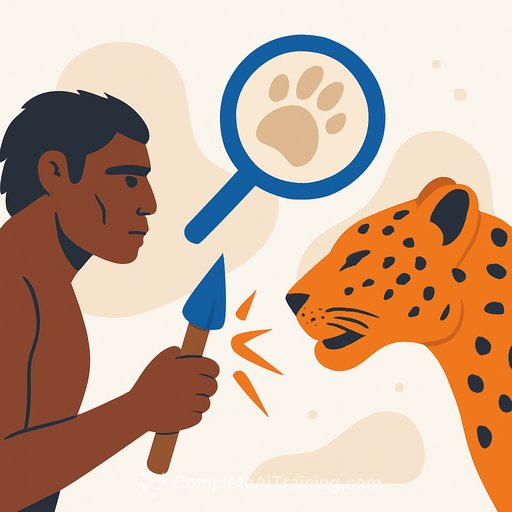AI Tooth-Mark Forensics Suggest Homo habilis Wasn't the Hunter We Thought
Almost 2 million years ago, early humans were clustering around lakes and springs in eastern Africa, moving carcasses, sharing food, and shaping stone. For decades, the go-to story was simple: Homo habilis started it, and Homo erectus scaled it. New evidence disrupts that timeline - and it comes from an unexpected source: microscopic tooth marks and computer vision.
Key takeaways
- AI analysis of tooth marks on Homo habilis bones points to leopard bites, not lion or hyena.
- If H. habilis was often prey, it likely wasn't the top predator driving big-game hunting.
- Homo erectus appears earlier than once thought and better fits the hunter profile at Olduvai Gorge.
- Early Homo sites (2.6-1.8 million years ago) show transport of tools and central places for sharing and butchery.
What the sites actually show
Olduvai Gorge preserves repeated events: early humans acquired animals as large as gazelles and zebras and brought them back to a central place for butchery and sharing. This is the earliest strong signal of frequent meat consumption and coordinated provisioning. At Nyayanga in Kenya, stone tools were transported up to ~13 km, a behavior that implies planning and social organization.
Who did the hunting?
If a species regularly hunts large prey or steals from apex predators, it tends to avoid becoming prey itself. That's how lions, and modern hunter-gatherers like the Hadza, operate. If Homo habilis was truly running the show, we'd expect fewer signs of predation on their own bones.
But many early human fossils from this period carry carnivore damage - including two of the best-preserved H. habilis individuals at Olduvai. The open question has been: scavenged after death, or killed by a predator?
How AI cracked the signal in the scratches
Researchers trained computer vision models on hundreds of microscopic images of tooth marks created by today's main African predators: lions, leopards, hyenas, and crocodiles. The models learned the subtle morphology of pits and scores each predator leaves on bone and classified them with high accuracy.
Multiple AI approaches converged on the same result: the marks on Homo habilis bones match leopards. The pattern - size, shape, and distribution - aligns with what leopards leave on their prey today. That's a strong hint that H. habilis was still on the menu.
The body doesn't lie
H. habilis remains from Olduvai include a very small individual (around 1 meter tall) with anatomy still friendly to climbing. That profile doesn't map well to a hunter capable of consistently taking large animals or stealing from lions. In contrast, Homo erectus shows a larger body, more modern limb proportions, and hands suited for life on the ground.
The timeline just got messy - in a good way
Finds from South Africa, Kenya, and Ethiopia push Homo erectus back to roughly 2 million years ago, slightly older than known H. habilis fossils. A hand bone from Olduvai dated to 1.85 million years looks more like erectus than habilis. The neat ancestry line (habilis → erectus → us) is no longer a safe bet. The tree looks bushier.
So who owned the toolkits and camps?
If H. habilis wasn't the apex predator at Olduvai, it's less likely they built the sites that show repeated big-game butchery and coordinated provisioning. Homo erectus is a stronger candidate for those behaviors: larger-bodied, more terrestrial, and present at the right time. That leaves a practical question: what was H. habilis doing at these sites? Co-existing, opportunistically feeding, or using simpler tools nearby?
Why this matters for researchers
- Method: Microwear and tooth-mark classification with computer vision can resolve predator-prey dynamics from fragmentary evidence.
- Behavioral inference: Apex status isn't a guess - it can be tested against damage patterns on hominin and faunal bones.
- Model of origins: A single Homo lineage likely drove early complex behaviors; current evidence points to erectus as the better fit.
Open questions worth funding
- What exact behaviors did H. habilis bring to shared sites if not persistent big-game hunting?
- Where did Homo erectus originate, and how quickly did its anatomy and behavior coalesce?
- Can broader AI-trained datasets separate pre- and post-mortem damage confidently across more sites?
Applying the AI lesson beyond paleoanthropology
The win here isn't just the conclusion; it's the workflow. Label the signal, train on real variation, ensemble multiple models, and validate against modern analogs. If you're exploring practical AI for research projects - especially computer vision - you might find value in this curated list of AI courses by job.
Bottom line: If leopards were chewing on Homo habilis, they probably weren't the top hunters shaping the earliest shared camps. The smart money is shifting to Homo erectus for the heavy lifting - and AI just helped tip the scales.
Your membership also unlocks:






